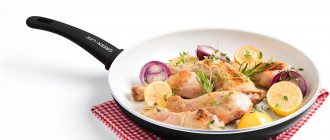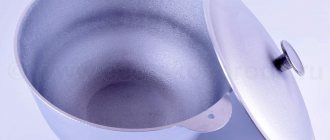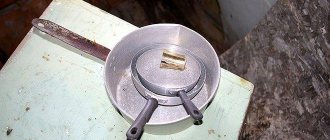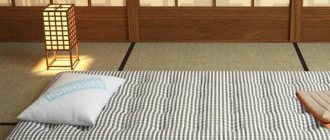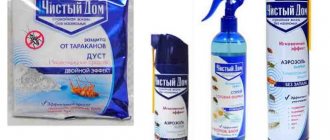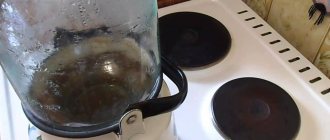Table Of Contents
- Frying pan-WOK - what is it
- Advantages and disadvantages of a wok pan
- Purposes of application
- Functions of a wok pan
- Types of wok pans
- Cast iron wok pan
- Metal wok pan
- Ceramic wok pan
- Diameter of frying pans-WOK
- Choosing a wok pan for the stove
- Gas stove
- Electric stove
- Induction cooker
- Types of coating for wok pans
- Wok-pans with stone coating
- Wok-pans with non-stick coating
- Criteria for choosing a wok pan
- Traditional Chinese wok
- Rules for caring for a wok frying pan
- Cleaning the walls of a wok pan from fats after cooking
- Features of recipes when cooking in a wok pan
- Frying vegetables in a wok pan
- Universal dishes in a wok pan
- How is a wok frying pan different from a regular frying pan?
Initially, the wok frying pan appeared on the territory of the Celestial Empire. It can often be seen in shops preparing various street cuisine dishes. The cookware is used in restaurants and at home, and it was invented by the poor Chinese because they tried to reduce the cost of the cooking process. The conical configuration was created to retain heat for a long time, and thick metal was also used. The result is quick cooking.
Frying pan-WOK - what is it
The dishes can be made of different metals, supplemented with coatings, the only thing that remains is the shape of the bottom part. The products are made this way for economical use of heat, cooking juicy and healthy food. The frying pans have round edges and allow you to fry in sunflower oil, grilled or steamed. Supporters of a healthy diet can cook without fat.
Important: It is possible to cook several dishes at once; in this case, the grill is used for steamed vegetables or curd desserts. Another use: Temporarily position finished foods to drain excess fat.
Recipes
Now that a successful purchase has been made and the frying pan has gone through the “opening” procedure, feel free to begin culinary masterpieces. So, what can you cook in a wok in 12-15 minutes? The list is long: they prepare pilaf, vegetable stew, roast, cook soups, create fries. And this is not a complete list of dishes that you can easily cook in your new frying pan. The recipes below will help you master cooking technology.
Zucchini soup
Peculiarities. This soup does not contain heavy or unhealthy foods. Therefore, it can be safely classified as a healthy dietary dish.
Ingredients:
- carrots - half a root vegetable;
- onion - one head;
- zucchini (small) – one;
- champignons – 200 g;
- sunflower oil – one or two tablespoons;
- tomato - two fruits;
- water – one and a half liters;
- herbs, spices, sour cream.
Preparation
- Initially, prepare all the ingredients: chop the onion; grate carrots, zucchini; cut the champignons, chop the tomatoes.
- Pour oil into the frying pan and wait until it gets hot.
- Add foods to the wok in the following order: onions, then carrots, followed by champignons, zucchini.
- When these components have simmered a little, add the tomato and chopped herbs.
- Pour boiling water into the pan and cook for a couple of minutes.
- Turn off the heat, cover the soup with a lid, and let the dish brew.
- When serving, add sour cream.
Fragrant risotto
Peculiarities. This dish will allow you to “touch” a little of the delicious and spicy Italian cuisine. You can adjust the spiciness yourself, taking into account your taste preferences.
Ingredients:
- ham – 240 g;
- dry red wine – 0.75 l;
- rice - one glass;
- sunflower oil – 25-30 ml;
- champignons – 150 g;
- red pepper (bitter) - a quarter of a pod;
- saffron, spices;
- water – 220 ml;
- hard cheese – 50 g.
Preparation
- Cut the ham, chop the champignons.
- Pour oil into a frying pan and heat it.
- Add the ham to the wok.
- Next add the champignons and simmer a little.
- Add rice and immediately pour wine over all ingredients.
- Stirring constantly, simmer the risotto until all the alcohol has evaporated.
- Add chopped red pepper (if you don't want a spicy dish, you can omit the chili).
- Season with saffron and spices.
- Pour in water and continue to simmer for another 20 minutes.
- Before serving, garnish the dish with grated cheese.
Healthy food lovers cook healthy steamed dishes in a wok pan. It's even easier. You need to pour water into the pan and insert a wire rack. Lettuce leaves are laid on it, meat, vegetables, and fish are placed on top. The entire structure is covered with a lid. If we are talking only about vegetables, then 30-45 minutes are enough for them to be ready. It may take 30-60 minutes to cook the fish. And it takes, on average, two hours to cook meat.
Video on the topic
Advantages and disadvantages of a wok pan
The cookware has noticeable differences from the standard pan format. In this case, it is worth considering a number of nuances of use, but there are more positive qualities:
- possibility of simultaneous preparation of several dishes. This speeds up the cooking process;
- the shape promotes rapid heating, the main heating is concentrated at the bottom;
- since there is a similarity with a stewpan, boiling, stewing, frying, baking, frying, deep-frying, and using steam are allowed;
- Maximum heating rate is ensured, so less oil and time are required.
Important: When stewing, be sure to stir the ingredients and monitor the heat level.
Pans also have some disadvantages:
- the dimensions can be quite large, so the structure is difficult to place on the stove, and it may not fit into the oven;
- handles often get hot;
- using a metal spatula accelerates wear, especially with Teflon coating.
Purposes of application
The vessel copes well with stewing, frying, boiling, baking, and the food can be healthy, nutritious and juicy. The design is also suitable for making French fries. Vegetable stews, French meat, Uzbek pilaf and much more are excellent. The food needs to be stirred and water added. A wok often replaces a steamer; usually a grate is provided for this.
Functions of a wok pan
Basically, frying pans are designed for frying foods, but combined cooking methods, stewing, and boiling can be used. Such high functionality has led to an increase in demand. You can cook with little or no fat, and Chinese cookware is also great for cooking with sauces.
Features of use
In order for the frying pan to serve you faithfully for a long time, provide it with decent care. If you purchased a steel or cast iron frying pan, then before using it for the first time, you must properly “open” it. Ceramic - just thoroughly wipe with hot water and soda to remove factory fuel oil.
"Opening" after purchase
The term “opening” means “applying a protective non-stick layer.” This is a mandatory procedure. As reviews of the wok pan show, in the future this “opening” will protect your food from burning and sticking to the cauldron. It is carried out only for carbon steel or cast iron. The opening algorithm involves 17 consecutive steps.
- Use a soft sponge to thoroughly rinse the surface of the frying pan to remove transport grease and dust.
- To completely remove all contaminants, pour water into a bowl and boil it.
- Pour out the liquid and wipe the surface.
- Turn on the hood or open the window as much as possible.
- Place the cleaned frying pan on maximum heat and let it get hot. The metal should acquire a bluish tint in the hottest places.
- Heat the pan around the entire perimeter, gradually tilting it at different angles.
- When most of the wok turns blue, pour in sunflower oil until it completely covers the bottom, approximately 80-100 ml.
- Rotate the pan to ensure the oil spreads evenly over the entire surface, but do not allow it to cool.
- After two to three minutes, turn off the heat.
- After another three minutes, bring the wok to running water, cool the outer surface first, then the inner.
- Place the cooled frying pan back on the heat and heat until the moisture evaporates.
- Pour in a little sunflower oil, about 40-50 ml, spread evenly over the surface.
- Heat until smoking appears.
- Remove from heat.
- Using napkins or a paper towel, rub the oil into the inside sides and bottom. Do not forget that the surface is hot, so use tongs or other devices that prevent hand contact with the metal.
- Now go over the outside surface with a cloth to protect the steel wok from corrosion.
- Leave the pan on the stove to allow it to cool on its own.
During the "opening" process you create an oil film. It will always remain on the surface. Therefore, such pans can only be washed with hot water and a clean brush (sponge). The use of detergents is strictly prohibited.
6 rules of cooking with wok
A frying pan is most often used for cooking dishes using the “stir-fry” principle. This term implies rapid frying with constant stirring. Cooking in a frying pan is easy. To make your food tasty, crispy and aromatic, you need to remember how to use a wok correctly and follow six simple rules.
- Preparation of components. You won't have any free time while frying. Therefore, cut all the products in advance so that you are not distracted from the stove during the cooking process.
- Evenly cooked. Cut the products into small pieces. Remember the following rule: the harder the product, the thinner it should be cut.
- Sunflower oil. It is not recommended to use olive oil for wok cooking. Creamy is also not suitable. Sunflower is considered the most optimal. And if possible, it is better to buy sesame and peanut ones.
- Preparing the pan. Initially, the frying pan is heated on fire, and only then they begin to lay out the food.
- Correct bookmark. Start the frying process by adding those products that require long-term heat treatment. For example, meat is always added initially. After frying it a little, add carrots. This is followed by chopped onions. Then you can add spices, pour in the sauce, and complete the composition with herbs.
- Mixing technique. Food cooked in a wok must be stirred constantly. And it needs to be done correctly. The spatula is inserted in the middle and mixed towards the edges. With this technique, products that have been processed on a hot bottom “reach” on the walls. It is this stirring that allows you to preserve the maximum amount of nutrients and protects the dish from burning.
Types of wok pans
Nowadays a huge selection of types of tools is offered, they differ in coating, external data, and type of handles. Therefore, the purchase should be made taking into account your own requirements and wishes. The material used affects the appearance, heating rate and application features.
Cast iron wok pan
What is the difference between cast iron models? They have maximum strength and long service life. These types of cookware look good, have considerable weight, and are suitable for stoves and open fires. Due to the characteristics of the material, the pans take a long time to heat up, but retain heat well.
Metal wok pan
Aluminum is often the chosen metal; it must be combined with a non-stick coating. Such products heat up quickly, but when very high temperatures are reached, harmful substances can be released from the used coating. Stainless steel also heats up quickly, is lightweight and can last a long time.
Important: Steel frying pans must be used correctly; if you choose a low-quality product, deformations will gradually appear.
Ceramic wok pan
Ceramics are completely safe for food, provide high heating rates and are compatible with any stovetop. In this case, temperature changes are not allowed, and the material is also fragile.
Description. Features of the cauldron-wok
Owners of a cauldron-wok can confidently say that this is a universal utensil that successfully combines the functionality of not only a wok and a cauldron, but is also a frying pan and a saucepan. With its help you can fry, stew, sauté and cook any dishes of European and Asian cuisine.
The cauldron wok has high sides, a rounded shape and a relatively small bottom. The design ensures uniform heating of products. The high sides allow you to actively mix the pieces being cooked without fear of them being thrown out of the container, and the comfortable bakelite handles do not heat up and provide a reliable grip.
For ease of use, manufacturers have equipped the product with a double-sided stone coating. It is based on a combination of polytetrafluoroethylene (a polymer responsible for the non-stick properties of the coating) and granite microparticles, which gives the product increased strength and hardness both on the outside and on the inside. Additional diamond coating on the inner surface guarantees mechanical strength and surface slipperiness.
To combine the heat conservation of a cast iron cauldron and the thermal conductivity of a wok in one item, the cauldron is equipped with an induction bottom with air ducts. By moving warm air in a spiral, it guarantees even distribution and long-lasting heat retention, ensuring high efficiency of the cooking process. The maximum heat on the bottom is ideal for high-speed, high-temperature cooking.
Such high-speed frying allows you to preserve the maximum useful content of the food and creates an appetizing golden brown crust with a crunch. At minimum heat and with the lid of the pan closed, the food will slowly simmer in its own juice.
The maximum heat on the bottom is ideal for high-speed, high-temperature cooking.
Due to the properties of the ceramic-granite coating and design features, the cauldron is easy to maintain and can be used with any type of stove:
- Electrical,
- Induction,
- Gas,
- With glass ceramic surface.
The outer layer of non-stick coating is guaranteed to maintain the ideal appearance of the cauldron-wok even after using a gas stove.
Differences between a cauldron and a wok
In ancient China, a round deep frying pan wok had low sides, a convex bottom, which made it possible to use it for quickly frying food over an open fire, and two handles that protected the cook’s hands from the heat of the hearth. Modern woks have flatter bottoms that allow cooking on any type of stovetop, and have a non-stick coating that minimizes the amount of oil used. They are also designed for high-speed cooking of juicy and healthy food with a crispy crust.
The cauldron wok has high sides and a lid.
What is the difference between a kazan-wok and a wok? Outwardly, it looks more like a wok than a cauldron - it is a fairly wide frying pan with thin walls (most often made of stainless steel) and two comfortable handles. It is also designed for quickly frying vegetables, but unlike classic and modern woks, the casserole wok has high sides and a lid, which turn it into a convenient frying pan and saucepan for preparing complex dishes.
Differences between a cauldron-wok and a cauldron
A cauldron is a traditional Central Asia cast thick-walled metal cauldron with a rounded bottom and a bow instead of handles. Without it, it is unthinkable to cook pilaf, shurpa and any other meat food over an open fire with minimal energy consumption. Due to the rounded bottom, when the cauldron is immersed in the fireplace, not only the bottom, but also the walls of the vessel are heated. Products quickly receive heat, abundant steam allows the contents of the cauldron not to fry, but to simmer, making the finished dish soft and aromatic.
Modern cauldrons are cast iron cauldrons with a flat bottom, maximally adapted for use on electric and gas stoves. An integral part of the cauldron is a tightly fitting lid with no gaps for steam to escape.
Kazan-wok successfully combines the functions of a cauldron and a wok in one frying pan.
Made from lightweight cast iron or steel, the cauldron-wok can be used in the same way for preparing pilaf or stewing meat, but due to its design features and the presence of comfortable handles, it can act as a frying pan for frying many other tasty and healthy dishes.
What is the difference between a wok and a cauldron? A wok is a thin-walled frying pan for quick frying in oil, a cauldron is a thick-walled cauldron for slow simmering. Kazan-wok successfully combines their functions in one frying pan.
Choosing a wok pan for the stove
The shape of the dishes was originally developed for Pan-Asian cuisine. At the same time, it is multifunctional and allows you to implement several methods of processing products. The convenience and taste of the dishes will depend on the choice.
Gas stove
The possibility of use on a gas stove must be specified by the manufacturer; usually all types of frying pans are suitable. An exception is products labeled “for electric stoves only.”
Important: Avoid frying pans with thin bottoms; they cannot withstand high temperatures.
Helpful Tips:
- A thick bottom is required.
- It is worth choosing a product with a diameter that matches the burner.
- An excellent option is to choose one that matches the burner you use for frying.
For gas stoves, grooves can be made to increase the heated area; they raise the temperature and speed up cooking.
Electric stove
Most models are suitable for electric stoves, but it is necessary to have a flat base equal to the size of the burner. Next, the sides bend and go up at an angle. It is worth considering the necessary dimensions, capacity, and equipment.
Including suitable:
- cast iron;
- aluminum with non-stick layer;
- stainless steel;
- ceramics.
Induction cooker
In this case, the slab is different from the usual one and requires the use of thick walls. Suitable steel or metals containing it, cast iron. There are no restrictions on the internal coating; Teflon, ceramics, titanium or stone coating are suitable. Models with enamel, nanocomposite or diamond coating are much less commonly used.
Important: If you buy cookware designed for induction heating initially, it will be easy to use and will last as long as possible.
NEW, premium cookware - what are the advantages?
Premium series frying pans , created using new patented technology, have higher performance qualities and have the following advantages compared to conventional cast iron cookware:
· increased silicon content . Silicon is a powerful catalyst for redox reactions and plays an important role in protein, fat, carbon metabolism, and in the formation of various hormones and enzymes. In addition, it is thanks to this element, which ranks second in abundance in the earth’s crust after oxygen, that the human body is able to absorb more than 70 vitamins, macro- and microelements. By using a Premium frying pan for cooking, you take care of your health!
· increased corrosion resistance to organic acids , which is achieved through special heat treatment by repeated calcination of finished products, immersing them in oil.
· increased heat resistance , which also leads to increased resistance to oxidation and greater resistance to volume changes at high temperatures.
· greatly increased scale resistance , which minimizes the possibility of destruction products entering the human body when preparing food in this cookware.
· higher wear resistance and hardness .
· new, more ergonomic design .
· perfectly flat, machined bottom .
Types of coating for wok pans
When choosing, the type of coating is often taken into account; this is important because it has a significant impact on the cooking process as a whole. Also, the inside of the frying pan comes into contact with food and affects its quality and safety. If there is a high-quality coating, the dishes are considered more practical.
Wok-pans with stone coating
The products are characterized by a long service life, reliability, ease of maintenance and hygiene. The coating allows you to use metal objects for stirring: ladles, spoons, spatulas.
Product advantages:
- tolerance to temperature fluctuations;
- safety and environmental friendliness;
- attractive design;
- cooking with a minimum amount of oil or without it is allowed;
- ease of care;
- Dishwasher safe.
Wok-pans with non-stick coating
When using a Teflon coating, food is resistant to burning. The coating is often used for Asian and domestic cooking.
Important: Non-stick frying pans are not acceptable when using the street-fry method. They also do not fit into the concept of this category of tableware, since they do not reflect the original authenticity.
If you use strong heating, toxic fumes will form on the surface, which will negatively affect your health. At the same time, dishes with Teflon can be used in the kitchen, but for sautéing and stewing in the standard way. Do not heat the frying pan to very high temperatures.
Why do you need a wok?
Such an unusual frying pan, according to chefs, can replace most kitchen utensils: pots, cauldrons, duck pots, frying pans. Moreover, food cooked in unusual Asian dishes will pleasantly surprise you with its taste and speed of cooking.
Main features of dishes stewed in a wok:
- Benefits for the body. Thanks to accelerated heat treatment, products practically do not lose nutrients. Therefore, food cooked in a wok is several times healthier than food cooked in a regular frying pan.
- Special taste. During accelerated frying and constant stirring, all products acquire aroma and an appetizing, crispy crust.
- Minimum fat. It doesn't require a lot of fat to cook in a frying pan. 1-2 tbsp is enough. l. oils Of course, such food can safely be considered a healthy diet.
The wok is designed for rapid frying. Chefs commonly use the term "stir-fry". Translated from English, it means “fry and stir.”
The frying pan is designed for cooking dishes using the “stir-fry” technology.
In the kitchen, a wok can become a real universal assistant. The frying pan allows you to:
- stew vegetables, meat (under the lid);
- cook soups;
- cook on a double boiler (using a special grill);
- deep fry.
Criteria for choosing a wok pan
When choosing, you should consider what the frying pan will be used for; the parameters will affect the aroma and taste. A wok with a convex firm bottom is considered a classic, while Western models are flat or close to flat. These adjustments are necessary because they allow the cookware to be used on electric or induction cooktops. The flat shape of the bottom ensures stability. Round models can be adapted to a modern kitchen, but additional stability rings are needed.
Traditional Chinese wok
Models of authentic shape are unusual and attractive, therefore, in addition to Asia, they have become widespread in Europe. The standard is a large round frying pan without a Teflon coating. This allows you to use burners and save on heating.
What you need to know about wok
A frying pan with the simple name wok is the favorite utensil of the residents of Asia and... It has a spherical or cone-shaped shape. Externally, the wok is very similar to a cauldron, but unlike the latter, it has thin walls. Thanks to this shape and thin walls, food heats up quickly and evenly in the pan. This allows you to prepare dishes almost at lightning speed.
The wok has a cone-shaped hemispherical bottom
A traditional Chinese frying pan has a rounded bottom, so the wok cannot stand on the stove without special tools. For Europeans, to make cooking much easier, adapted analogues with a flat bottom were created.
Introducing a Chinese frying pan - video
Rules for caring for a wok frying pan
A new frying pan needs to be prepared; the process includes a number of steps:
- High-quality cleaning, removal of dust and dirt.
- Warming up for the purpose of glowing. The walls and bottom must be fired under high temperature until a dark shade appears.
- Filling the container with water.
- Repeating the cleansing process. It is necessary to pour out the water and rinse the pan outside and inside.
- Repeating the calcination process. The cookware should be placed on maximum heat.
- Use of oil. After darkening, you need to add vegetable oil, carefully distributing it over the surface.
- Turn off the heat source for approximately 3 minutes.
- Rinse with water and cool.
- Oil coating and reheating.
- Removing oil after smoke appears. Turn off the fire by removing the oil using paper napkins.
Important: This process is not performed with a non-stick coating, otherwise the cookware will be damaged.
It is better to use plastic spatulas and eliminate temperature fluctuations.
Cleaning the walls of a wok pan from fats after cooking
When performing cleansing, the following rules are provided:
- It’s better to stick to gentle cleansing formulations;
- washcloths should be soft;
- It is necessary to wash dishes after each use.
Important: Care details depend on the material and coating of the frying pan. Teflon does not allow sharp objects, and ceramics are easily damaged by impact.
Tips for choosing a wok
Having decided to purchase a wok, you need to pay attention not only to the material and coating, but also to a number of important nuances that will greatly simplify the process of using the frying pan.
Bottom configuration
The first thing you should pay attention to is the shape of the wok. If you have a gas stove in your house, you can purchase a traditional Chinese hemispherical frying pan. Owners of induction and electric cookers are recommended to use more stable woks with a flat bottom.
If the choice is a traditional frying pan, then it is advisable to purchase special rings in advance that will hold the wok on the stove. Otherwise, the housewife will have to not only mix, but also “juggle” the dishes by weight.
European housewives prefer flat-bottomed woks
Pan sizes
The next parameter that deserves attention is the diameter of the bottom. The wider the base of the pan, the more portions you can cook in a wok . However, large frying pans are too bulky and inconvenient to use.
To choose the right wok, you need to take into account the number of servings that are regularly prepared in the family:
- For 1 serving, a frying pan with a bottom of 15–20 cm is suitable;
- for 2 – 20–28 cm;
- for 3-5 servings - you will need a wok with a bottom diameter of 30-38 cm;
- for 6–10 – you can take dishes with a bottom of 40–50 cm.
Types of pens
Woks are produced with one or two handles. The choice of model depends entirely on what functions will be assigned to the “cauldron” and personal preferences:
- Model with 2 handles. If you plan to cook for a large company or only using the “stir-fry” principle, then it is better to prefer the classic version of a wok with 2 handles. This cauldron is much easier to lift and shake while cooking.
- Wok with 1 handle. This option is more familiar and convenient for Europeans. It makes the wok look not like a cauldron, but like an ordinary frying pan.
If the choice is a wok with 2 handles, then models in which the handles do not heat up are preferable.
There are models of woks with a removable handle. This model will appeal to those who like to bake dishes in the oven.
Equipment
On sale you can find frying pans equipped with a whole set of additional accessories. It is best to choose just such kits. Additional parts significantly expand the functionality of the wok.
Particular attention should be paid to the presence of the following elements in the kit:
- Lattice. This detail will allow you to cook two dishes at the same time. For example, stew vegetables and steam cutlets.
- Lid. It is this attribute that will allow, if necessary, to transform the wok into a saucepan for cooking soup or a cauldron for stewing stew.
Particular attention should be paid to the presence of the lid and grille
Recommendations for choosing - video
Features of recipes when cooking in a wok pan
In most cases, a wok is chosen for the purpose of quick frying; the method is also called stir-fry. The following possibilities are expected:
- deep fat formation;
- stewing vegetables and meat;
- cooking soups;
- steam cooking.
To obtain the desired taste and color of food, you need to take into account the features of the dishes. Fine cutting into identical components is recommended. Next, they are placed in the recess one by one, taking into account the time required for cooking.
Important: Stirring is necessary, especially at maximum heat. It is believed that this is how food retains its properties.
Frying vegetables in a wok pan
Vegetables can be boiled or stewed. If deep frying is used, oil is filled to 2/3 or ½ capacity. Deep frying provides an appetizing crust and allows you to achieve attractive taste.
Universal dishes in a wok pan
If the street-fry technique is used, models with one handle will be suitable. Most dishes can be prepared within 10-25 minutes. Cooking in this format allows you to preserve nutrients and vitamins; food is considered healthier than cooking in a standard frying pan. The reason is separate portioned frying, each ingredient is prepared in a small portion, it can be done in 3-5 minutes.
Important: If you need to minimize fat consumption, just use a spoonful of oil; the excess is absorbed into the walls.
During high-speed frying, a protective crust is formed, and the meat and vegetables inside remain juicy.
Fried udon noodles with beef
Photo: Shutterstock.com/ Victority
Recipe by Chef Chen Yongjian
- 70 g marinated beef
- 200 g udon noodles
- 40 g soy sprouts
- 20 g bell pepper
- 10 g shiitake mushrooms
- 10 g green onions
- 5 g sugar
- 5 ml sesame oil
- 10 ml oyster sauce
- 2 g garlic
- 5 ml soy sauce
- 5 ml chicken sauce
Step 1. Boil the noodles.
Step 2. Cut the pepper into strips, mushrooms into large slices, finely chop the garlic.
Step 3. Cut the beef into thin strips, quickly fry in a wok, then add vegetables and fry as well.
Step 4. Mix oyster sauce, soy sauce with sugar and sesame oil. Pour the resulting mixture into the wok, heat slightly and add chicken sauce.
Step 5. Mix all ingredients with noodles. Fry in a wok for 5-8 minutes and place on a plate.
How is a wok frying pan different from a regular frying pan?
The wok differs from standard frying pans in the presence of rounded walls; initially, an exclusively convex bottom and thin high walls were provided. There are two handles, there are models with one handle. Popular materials are carbon steel and cast iron; modern variations have expanded the list of shapes and materials.
In China, cooking is often done using specialized burners, so round-bottomed cookware is ideal. There is a recess in the center that ensures stability, and due to the powerful flame, heating occurs very quickly.
Equipment
A casserole wok with a lid is a practical model that combines the functionality of a frying pan, wok, saucepan and pressure cooker. Most manufacturers produce cookware from different materials and with different coatings, but the principle of operation is the same for all. On sale there are wok cauldrons made of lightweight cast iron and steel with two handles (long and short) and a lid made of stainless steel or heat-resistant glass.
The “Power of Granite” cauldron is made of high-quality stainless steel and has a multi-layer structure with an external and internal layer of non-stick coating, as well as a special design of a thickened induction bottom with an air duct system. The heat distribution in this design is in a spiral, due to which the walls heat up quickly and the food is evenly cooked on all sides.
Lid with steam valve
Unlike the classic wok, the “Power of Granite” casserole wok is equipped with a transparent heat-resistant glass lid with a handle. Its distinctive feature is the presence of a steam valve, a silicone heat-resistant rim and a unique locking system that ensures that the lid is tightly suctioned to the sides of the pan.
The steam valve is an indicator that the lid is closed and at the same time serves to remove excess steam. Using a valve and a silicone rim, a vacuum is created in the container, the pressure increases, and the boiling point increases. Due to this, the speed of cooking increases, and when the heating temperature is set to minimum, the food simply simmers.
The steam valve is an indicator that the lid is closed and at the same time serves to remove excess steam.
The glass lid creates the required temperature without losing heat and preserves the aroma of the dish. It is convenient to observe the cooking process through the transparent glass.
The lid is equipped with a comfortable bakelite-coated handle, the design of which ensures a stable vertical position when removed.
Due to the tightness of the lid, food retains its fresh appearance and taste longer.
